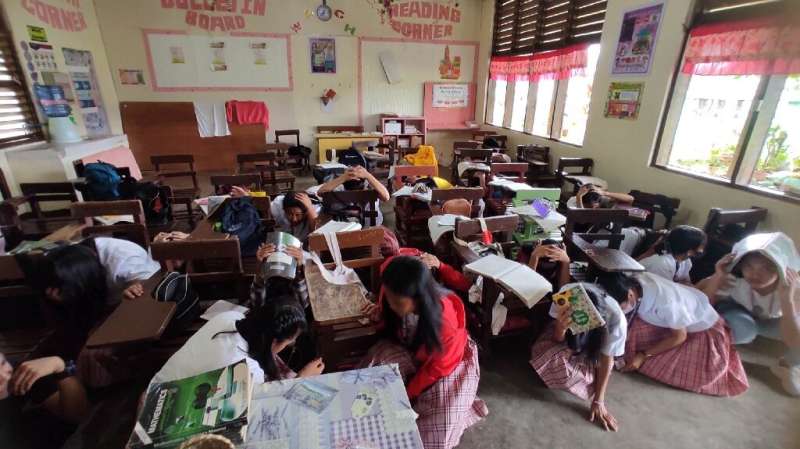This article has been reviewed according to Science X's editorial process and policies. Editors have highlighted the following attributes while ensuring the content's credibility:
fact-checked
reputable news agency
proofread
Two strong earthquakes rock southern Philippines

Two strong earthquakes jolted the southern Philippines on Tuesday, authorities said, with the second damaging buildings and forcing the evacuation of hundreds of villagers from their homes.
A 6.0-magnitude quake struck at about 2:00 pm (0600 GMT), a few kilometers from Maragusan municipality in the mountainous gold-mining province of Davao de Oro on Mindanao island, the US Geological Survey said.
Local authorities said there were no reports of casualties or significant damage.
But a shallower second quake, measuring 5.6 magnitude, hit nearly three hours later in the neighboring municipality of New Bataan, triggering the collapse of some houses.
New Bataan disaster officer Lynne Dollolasa said nearly 300 people were forced to leave their homes in Andap village, where "a number of houses collapsed".
About 100 people inside a shopping mall in Tagum city, in the adjacent province of Davao del Norte, were hit by falling glasses and plates as they fled the building, said Jay Suaybaguio, the provincial information officer.
"I was in the third floor buying office supplies when the quake suddenly struck," Suaybaguio told AFP.
"When we reached the first floor we saw broken bottles of wine and condiments. The lights went out but emergency lights turned on, helping us to find our way."
Photos posted on the Facebook page of the Davao del Norte disaster agency showed collapsed ceiling sections inside another Tagum shopping mall, which it attributed to "the series of earthquake incidents".
The Davao del Norte government suspended work and classes on Tuesday and Wednesday to allow for inspections of public buildings and infrastructure to ensure public safety.
The first quake lasted about 30 seconds and was followed by aftershocks, said Corporal Stephanie Clemen, a police officer in Tagum, about 40 kilometers (25 miles) from Maragusan.
"We immediately went under our desks and when the ground stopped shaking we went straight outside," Clemen told AFP.
"We are still outside because a moderate aftershock just hit."
While the quake did not appear to have destroyed anything, Clemen said, it was strong enough to "cause fear".
Quakes are a daily occurrence in the Philippines, which sits along the Pacific "Ring of Fire", an arc of intense seismic and volcanic activity that stretches from Japan through Southeast Asia and across the Pacific basin.
Most of the earthquakes are too weak to be felt by humans, but strong and destructive ones come at random with no technology available to predict when and where they will happen.
The nation's civil defense office regularly holds drills simulating earthquakes along active fault lines.
The last major quake was in the northern Philippines in October.
The 6.4-magnitude earthquake hit the mountain town of Dolores in Abra province, injuring several people, damaging buildings and cutting power to most of the region.
A 7.0-magnitude quake in mountainous Abra last July triggered landslides and ground fissures, killing 11 people and injuring several hundred.
© 2023 AFP



















